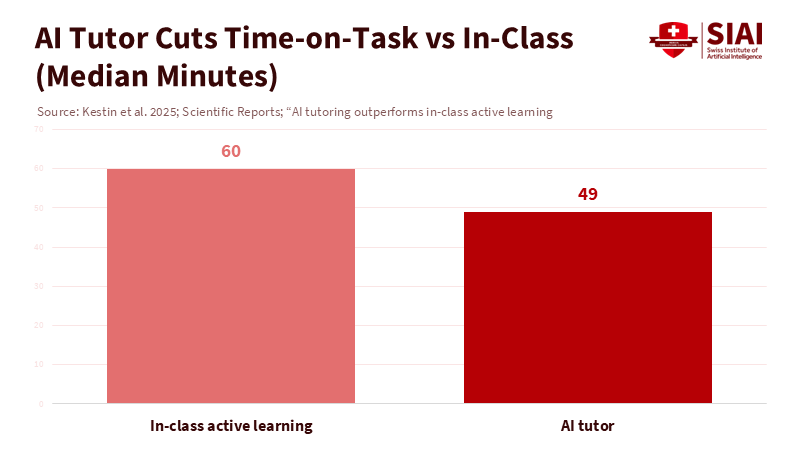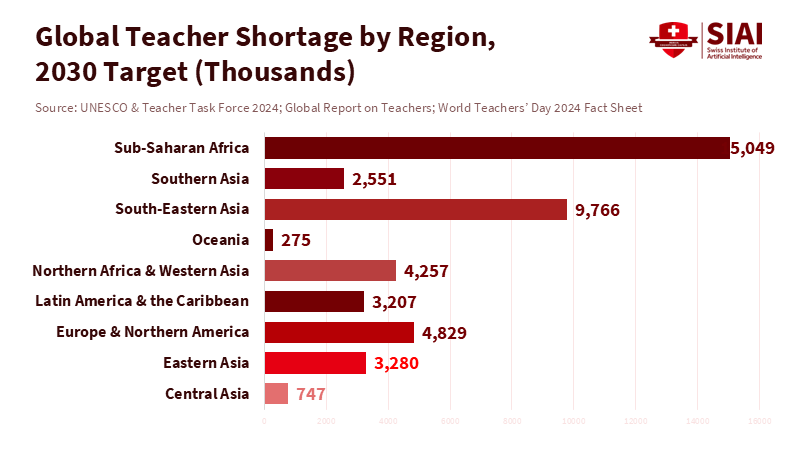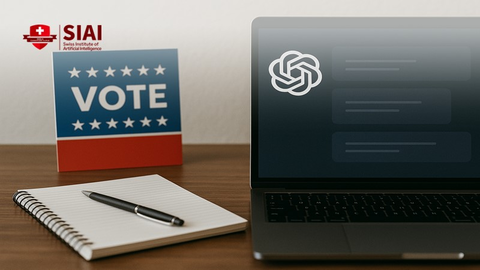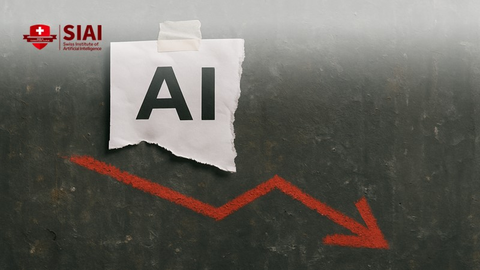AI Agents in Education Can Double Learning, So Let’s Design for Homes, Not Just Enterprises
Published
Modified
AI agents in education boost learning while cutting time Build home-first workflows for practice, planning, and records Scale with evidence and guardrails to protect equity and trust

One data point should change our thinking: a recent study shows that students using an AI tutor learned significantly more, and in less time, than those in an active learning class covering the same material. The AI tutor used evidence-based teaching methods and still performed well. This is not just a marketing claim; it is supported by peer-reviewed research. Suppose an AI tutor can save time and improve learning in controlled settings. What happens when these “agentic” systems are used in the family home, where most homework takes place? The effects are real. They point to the potential for families to adopt AI agents in education that assist children each night, coach parents, and allow schools to focus their limited human expertise where it is most needed. In short, AI agents in education are transitioning from novelty to necessity, and the question is how quickly we can adjust to that reality.
We can see the shift in usage data. In 2025, 34% of U.S. adults reported using ChatGPT, roughly double the 2023 figure. Among UK undergraduates, use of generative tools increased from 66% in 2024 to 92% in 2025. Teen adoption is also growing: 26% of U.S. teens reported using ChatGPT for schoolwork in 2024, up from 13% the previous year. None of this guarantees learning improvements, but it shows where attention and effort are being directed. The opportunity now is to turn basic tool use into accountable, agent-led workflows that prioritize families first, schools second, and vendors last. This means creating a dependable “home system” for tutoring, planning, and documentation that works just as well on a Tuesday night as it does on a weekend for test prep.
AI agents in education: from single tools to household systems
An AI agent is more than just a chat window. It is software that can plan tasks, use tools, and work towards a goal. Businesses are already using agents to answer complex questions, manage workflows, and connect different systems. The lesson for schools is clear: what works in business will also work at home. Families need agents that help children study, automatically log progress for teachers, draft emails about accommodations, and schedule therapy sessions without paperwork getting lost. The key points from consulting apply at home: it’s not just about how intelligent the agent is; it’s about redesigning the workflow around what learners and caregivers actually do. Focus on the weekly rhythm of assignments and supports rather than worrying about flashy demonstrations.
A clear example of where this is heading comes from a recent story about a parent who used “vibe coding” tools to build an AI tutoring platform for her dyslexic son. She did not wait for a perfect product. She combined research-based prompts, dashboards, and student intake forms to personalize the agent’s guidance, drawing on hundreds of studies about learning differences. The result was not a toy; it was a home setup that adjusted to the child’s motivation and needs. When a parent can create a functioning tutor, we have entered a new era. For context, specialized reading support in the U.S. averages about $108 per hour. An AI agent that can enhance or partially replace some of those human sessions changes the dynamics of time, cost, and access—all while keeping the human specialist for the more complex parts.
What AI agents can do for families now?
We should identify specific use cases because they relate to real challenges families face. Start with support for reading and writing. Recent evidence shows that AI tutors can deliver greater gains in less time when designed around effective teaching methods. This makes agents ideal for structured, paced, and responsive nightly practice. Add school logistics: an agent can extract deadlines from learning platforms, generate study plans, and remind both children and caregivers. It can summarize teacher feedback into two specific actions per subject. It can maintain a private, ongoing learning record that parents can share at the next meeting. Because these are agents, not static programs, they can access external tools to retrieve school calendars, assemble forms for accommodations, or draft that email you've been putting off.

Families also need help connecting limited, costly expert support with critical moments. Reading intervention tutors are essential, but capacity and cost are issues. With agents enabling focused practice between sessions, children can arrive ready for human instruction. This does not mean total replacement; it means better use of resources. Additionally, broader tool usage suggests families are becoming comfortable asking AI for help with information and planning. Surveys show that many adults rely on AI to search and summarize, and students report routine use. Suppose we can direct that comfort toward a household agent focused on learning goals. In that case, we can reduce back-and-forth communication, minimize wasted time, and make the hours spent with a human expert more effective.
Risks, equity, and the danger of “agent washing”
There is a strong temptation to label every scripted workflow an “agent.” Analysts caution that many agent projects may fail within 2 years because teams pursue trends rather than results. This warning is essential in education, where trust is the most valuable asset. The safeguard against soaring expectations is precise planning and measurable outcomes: time on task, growth on validated assessments, and teacher-observed application. This also means avoiding unsafe autonomy. Household agents should have limited default functions, operate under strict guidelines, and provide logs that parents and teachers can quickly review. The standard must focus on verifiable improvements, not flashy showcases.

We also need strong protections for equity. Global policy organizations warn that AI's potential will vanish if we ignore access, bias, and data handling. This is not just hand-wringing; it is about practical design. AI agents in education must prioritize human-centered guidance, protect student data, and be implemented with teacher training and clear rules. We should account for low-resource settings—for instance, offline options, simple devices, and multilingual prompts. Remember the staffing challenge: the world needs millions more teachers this decade to achieve universal education goals. Agent systems should help by taking on routine tasks and structured practice, not by replacing irreplaceable specialized roles.
A playbook to make AI agents in education work—at home and at school
Start with small, manageable successes. Pick one subject and one grade level. Use an agent to assign tasks, coach, and check practice aligned with the existing curriculum. Treat the agent as a redesign of the workflow, not an add-on tool. The most effective implementations in industry focus on the process rather than the tool itself; schools should do the same. As usage increases, integrate the agent with gradebooks and learning platforms to automatically populate progress logs and reduce administrative burdens. Monitor fidelity: if the agent’s prompts stray from the curriculum, correct them. The goal is to free up teacher time for valuable feedback and meetings while providing families with a reliable nightly routine.
Then scale based on evidence. Use validated measurements and compare agent-supported practice against standard methods. If the results favor the agent, make it official. If they do not, adapt or stop. Build trust within the community by showing not only that students used an AI tool but that they learned more in less time. That is the standard set by recent research on AI tutoring.
Meanwhile, monitor usage trends. Both adult and student use indicates that agents are becoming part of daily life; institutions should meet families where they are by offering approved agent options, clear data policies, and easy-to-follow guides. Finally, align purchasing strategies to avoid “agent washing” by using straightforward criteria for limits on autonomy, logging, and outcomes. This reduces vendor turnover and keeps the focus on learning rather than features.
An AI tutor can lead to much more learning in less time than an active-learning class covering the duplicate content. This single insight serves as a guiding principle for policy. It suggests that the right kind of AI—integrated into a workflow, limited for safety, and measured by outcomes—can help families gain hours back and help schools focus on their valuable human expertise. The consumer trend is moving in the same direction, as adults and students incorporate AI into their everyday tasks. The task ahead is to direct that momentum into accountable agents designed for home use and connected to schools. If accomplished, “AI agents in education” will evolve from a buzzword to a dependable part of every household’s learning resources. The key question is simple: do students learn more, faster, without compromising trust or equity? If the answer is yes, we should scale and start now.
The views expressed in this article are those of the author(s) and do not necessarily reflect the official position of the Swiss Institute of Artificial Intelligence (SIAI) or its affiliates.
References
Axios. (2025, September 18). AI can support 80% of corporate affairs tasks, new BCG report says.
British Dyslexia Association. (2025). Dyslexia overview.
HEPI & Kortext. (2025). Student Generative AI Survey 2025.
McKinsey & Company. (2025, March 12). The State of AI: Global survey.
McKinsey & Company. (2025, September 12). One year of agentic AI: Six lessons from the people doing the work.
Pew Research Center. (2025, January 15). About a quarter of U.S. teens have used ChatGPT for schoolwork.
Pew Research Center. (2025, June 25). 34% of U.S. adults have used ChatGPT.
Reading Guru. (2024). National reading tutoring cost study.
Reuters. (2025, June 25). Over 40% of agentic AI projects will be scrapped by 2027, Gartner says.
Scientific American. (2025). How one mom used vibe coding to build an AI tutor for her dyslexic son.
Stanford/Harvard team via Scientific Reports. (2025). AI tutoring outperforms active learning. Scientific Reports.
Teacher Task Force/UNESCO. (2024, October 2). Fact Sheet for World Teachers’ Day 2024.
UNESCO. (2023, updated 2025). Guidance for generative AI in education and research.
OECD. (2024). The potential impact of AI on equity and inclusion in education.
Oracle. (2025). 23 real-world AI agent use cases.






















Comment